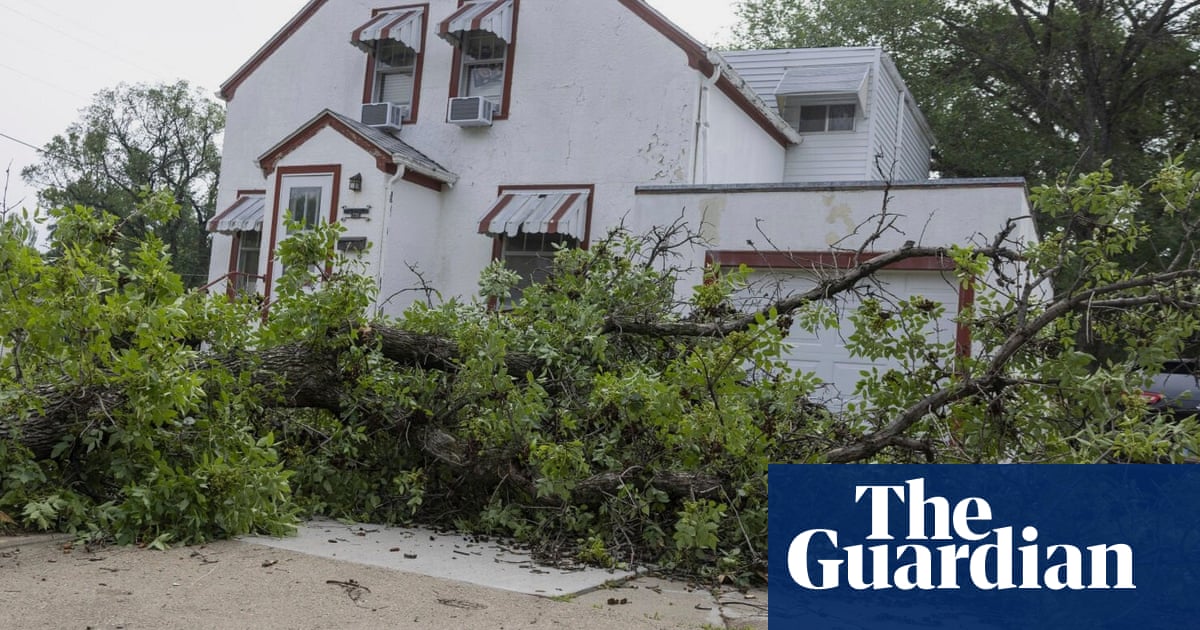Powerful winds – including a tornado – that swept across parts of the upper midwest left three people dead and a regional airport heavily damaged, while nearly 150 million Americans were under a heat advisory or warning as the weekend warmed up in much of the US.
A complex storm system wreaked havoc in parts ofNorth Dakota, northern Minnesota and northern Wisconsin, with reported tornadic activity, large hail and strong wind gusts, according to Brian Hurley, meteorologist with the National Weather Service’s Weather Prediction Center.
Cass county sheriff Jesse Jahner said at a news conference Saturday that two men and a woman were killed late Friday at two locations around the town of Enderlin, North Dakota, about 40 miles (60km) south-west of Fargo. Thousands of households lost power.
Hours earlier the National Weather Service in Grand Forksconfirmedon social media that two deaths were attributed to a tornado that hit a home.
Timothy Lynch, lead forecaster with the NWS office in Grand Forks, said the storm was confirmed as a tornado but crews were still working to determine its strength and highest wind speeds. He said the storm impacted the neighboring counties of Cass and Ransom.
“We still have people out investigating and gathering information on what happened. It was a pretty major event,” Lynch told the Associated Press.
Governor Kelly Armstrong said in a statement that the NWS confirmed a second tornado touched down near Spiritwood, which is about 80 miles (130km) west of Fargo. Armstrong issued a statewide disaster declaration to respond to the damage.
Heavy winds also swept across localized areas ofMinnesota, and the NWS reported wind gusts of up to 106mph (171km/h) at Bemidji regional airport overnight.
“I cannot ever recall hearing a rushing wind like that!” Bemidji mayor Jorge Prince posted on Facebook in the early hours of Saturday. “Emerged from our basement to find our neighborhood with lots of trees down and several homes with severe damage.”
Prince also said officials were responding to many knocked down power lines and several gas line leaks. Localized torrential rain flooded the city’s downtown and stalled vehicles, Beltrami county emergency management director Christopher Muller said.
Many Bemidji-area businesses posted on social media to say they were without power and closed for the day. Muller warned people to prepare for “long-term power outages” because of damage to infrastructure.
Hurley said that same storm moved on in a weakened state to parts of Michigan. It was expected to cross over lower Ontario and back into the United States to hit upstate New York on Saturday night into Sunday.
“Still wind and hail threat,” Hurley said of the enhanced risk to upstate New York. “It doesn’t look like it’s going to be as robust perhaps as we saw last night.”
Warm and dry conditions coupled with frequent thunderstorms and lightning have resulted in more than 100 fires in the state since Wednesday.
“A lot of those fires are in vast wilderness areas of Alaska where fire is allowed to take its natural course,” said Sam Harrel, an information officer with the state’s Division of Forestry and Fire Protection.
But some fires were threatening populated areas, prompting evacuations in the interior region. Among them was a go order issued Friday for areas near Fairbanks, according to Harrel.
A fire burning about 30 miles (50km) north of the entrance to Denali national park and preserve also prompted an evacuation “due to escalating fire conditions”, the Denali Borough said via Facebook.
“Numerous structures are now imminently threatened so aircraft including Air Tankers and helicopters are supporting the fire with retardant and water drops,” the borough added.
Harrel said the fire was not affecting the status of the park but the smoke could worsen air quality for visitors.
